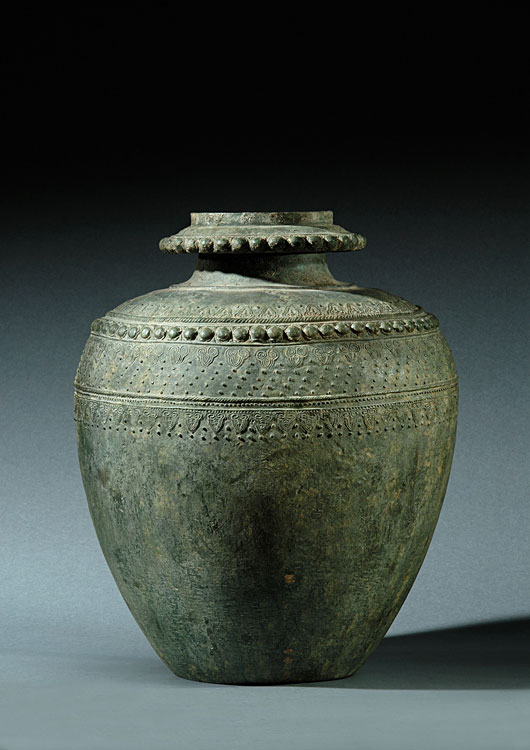

|
Vase Cambodia, Kingdom of Nokor Phnom circa 5th century Bronze, cast in the lost wax method height 53 cm. |

This bronze vase reveals the impressive technological ability of the early Khmer artisans. Their distinctive style was particularly evident in narrow-mouthed vases and urns with intricate floral designs. In Buddhism, the vase or kalasha contained amrita, the elixir of immortality. In that context the present vase was probably created to serve an altar in an early Cambodian sanctuary. The vase has a splendidly rounded voluminous body and a narrow gently curved neck encircled by a wide collar. The lotus is the symbol of water and creation and has always had great importance in both Hindu and Buddhist iconography. The vase is decorated with three rows of finely stylized lotus leaves regularly arranged beads, separated by horizontal cords and beated bands. Notable are the two rows of large pearls, which underline the vessel�s original importance. In contrast to Cambodian sculpture, little has been written about the country�s early metalwork. Religious artefacts were made long before the unification of the Khmer empire by Jayavarman II in the ninth century. According to the previous owner, this vase was excavated near Angkor Borei in southern Cambodia. This royal city was once surrounded by a brick wall four meters high and four kilometres long, and was an important cultural centre in the Kingdom of Nokor Phnom (Funan). This powerful state, established by Mon-Khmer settlers, conducted a lively maritime commerce. From as early as the first century, Indian traders introduced knowledge and religious beliefs that significantly aided the development of this first Khmer empire in the Mekong delta region. In 357 Funan became a vassal of China and remained so until its disintegration in the sixth century. The vase�s pure natural shape with its gentle and harmoniously flowing volumes, pronounced features and deep natural patina, can be compared with bronze artefacts of the Nokor Phnom period [1]. This extremely rare bronze vase is of an imposing and pure volume and is in a good state of preservation. The lotus leaves, beads, pearls and other features are finely delineated, creating an organic rhythm that gives great life to the piece. Its original function as a religious utensil seems to endow it with a particular tension and energy, its own mysterious character. The intense and beautiful natural green patina complements the presence of this unique example of early Cambodian metalwork. [1] L. Malleret, l�Arch�ologie Du Delta Du Mekong, E�ole Fran�aise d�Extr�me-Orient, 1963. |